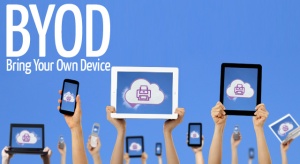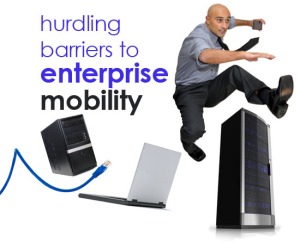Bye bye, corporate phone!
2011 was the first year where the sale of electronic devices like smartphones and tablets beat the number of PC´s sold. It is a  completely logic effect regarding to the improvements in functionality. Many of these devices now have functionality that is equal to the laptop or home computer of only a few years ago. In particular businesses benefit from mobile devices that provide access to email, calendars and business documents as well as the possibility of flexible working arrangements.
completely logic effect regarding to the improvements in functionality. Many of these devices now have functionality that is equal to the laptop or home computer of only a few years ago. In particular businesses benefit from mobile devices that provide access to email, calendars and business documents as well as the possibility of flexible working arrangements.
When I worked at Rohde&Schwarz International Operations the company provided it´s employees with all the required tools and equipment that they need to perform their jobs; this has been true for large organizations. But for smaller enterprises that do not have the money to provide their people with everything, the employees bring their own tools to work. And this strategy has a name: Bring Your Own Device Model or simply BOYD Model.
Advantages of BOYD
When employees bring their own devices, they can work more comfortably and the employer saves on hardware costs and maintenance while the data security issue is handled by the cloud application. Since Julia wrote about Cloud Computing in her last blog I don´t need to explain that term again. Cloud Computing’s role is one of security. Services like desktop hosting allow the entire desktop environment of your office pc to run on any device with a big enough screen and internet connectivity. Even if employees use their own devices for work, the employer is able to control which applications and what data are accessible and where, preventing it to be even saved locally, only on the cloud desktop environment.
The personal devices afford employees more freedom because they can work at home and at the office. Regarding to Peter Silva in his series on BYOD policies for SYS-CON Media using their preferred device makes employees happier and therefore more productive. He goes on to say that
“80% of Americans work an extra 30 hours a month on their own time with BYOD,”
citing research from Good Technology.
In the first moment all that sounds like a win-win situation for me. But…
BOYD – Bring your own disaster?
Let´s take a look at the other side of the coin. Bensonoff Kirill mentions the so-called, Blackberry addiction in his blog. It means that workers are permanently available and in touch with their work. The problems which are coming along with that were already dealt with in my former blog “The Manager you have called is temporary not available!”
Privacy –The informtion law group cites the “creep-out factor”. It means that most employees are afraid of an invasion into their privacy. The computer they use for work will also be the same computer they surf the web or use to sign up into Facebook and Twitter. Employees are suspicious towards their company of being able to “spy” on them and have access to their personal passwords, websites and data.
Data Security –This is the biggest point which should be considered when implementing BYOD model. Refering to Gartner, letting employees use their own devices for work purposes can lead to pertinent company data being visible. The problem IT departements are encountering is trying to find the best method to allow users to access all data necessary while keeping that data safe and secure. Since BYOD is a relatively new concept for organizations, there isn’t a “best policy or practice” for organizational data security. Organizations are beginning to establish guidelines and policies to better manage BYOD security, but determining which is best for the organization may lead to unexpected costs. According to Liam Keating, Intel’s IT country manager for China
“you encounter tricky scenarios where, let’s say, you have to confiscate a personal device, because it has been compromised and it needs to be examined forensically.”
Now, Intels workers need to sign an agreement about when they have had access to their e-mails, calendar etc.
Future of BOYD
We’ve all become dependent on connectivity and computation, turning us into tablet- and smartphone-toting cyborgs. How will this trend evolve in 2013? I got so much used to my mobile devices like my iPad or iPhone that I tried to open Mozilla Firefox by touching my work computer´s screen.
But experts are not unified if they are asked about their predictions for BOYD in 2013. Kenneth ‘Ken’ Hess is a full-time Windows and Linux system administrator with over 15 years of experience who thinks that personal clouds such as Dropbox, iCloud or Google Drive will curb the BOYD hype. His resumee is, that
“Personal cloud services are convenient, inexpensive, always available, and on the brink of destroying the entire BYOD movement.”
Others declare the BOYD trend as to be full in swing. The same opinion shares Cesare Garlati, vice president of mobile security at Trend Micro even if he considers potential pitfalls. Garlati puts it:
“There’s no point trying to stop this drive towards BYOD. Consumerization is unstoppable and BYOD brings real business value but a lack of a strategic approach can create security risks, financial exposure and a management nightmare for IT departments.”
BOYD was voted among the Top-Tech-Trends 2012 a couple of times by different rankings such as carouselconnect , petri, or by the bigfatfinanceblog.
 In my opinion this trend will become increasingly popular in 2013. More and more, particularly small and middle-class firms will adopt this model to safe money. And with an increasing number of freelancer due to outsourcing, Enterprise Mobility is essential for companies to correspond with their on-road-employees. But not every phone works on every network abroad so it´s useful that every worker has his/her own device. Another point might be the growing technical knowledge of the next generation. We are facing an unbelievable variety of mobile devices therefore every individual has his/her own preferences regarding their mobile friends. With the BOYD Model they won´t be forced to work with a provider or brand that they absolutely don’t like.
In my opinion this trend will become increasingly popular in 2013. More and more, particularly small and middle-class firms will adopt this model to safe money. And with an increasing number of freelancer due to outsourcing, Enterprise Mobility is essential for companies to correspond with their on-road-employees. But not every phone works on every network abroad so it´s useful that every worker has his/her own device. Another point might be the growing technical knowledge of the next generation. We are facing an unbelievable variety of mobile devices therefore every individual has his/her own preferences regarding their mobile friends. With the BOYD Model they won´t be forced to work with a provider or brand that they absolutely don’t like.
The chart on the left shows that 71 percent of employers already allow personal devices in the office. That´s a big percentage with increasing tendency!
2013 will give us the final answer, I am curious!

